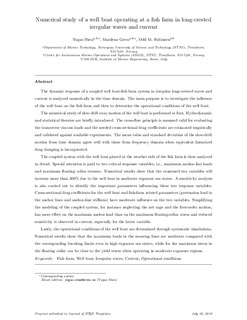| dc.contributor.author | Shen, Yugao | |
| dc.contributor.author | Greco, Marilena | |
| dc.contributor.author | Faltinsen, Odd Magnus | |
| dc.date.accessioned | 2019-02-26T15:19:51Z | |
| dc.date.available | 2019-02-26T15:19:51Z | |
| dc.date.created | 2018-12-12T13:19:18Z | |
| dc.date.issued | 2019 | |
| dc.identifier.citation | Journal of Fluids and Structures. 2019, 84 97-121. | nb_NO |
| dc.identifier.issn | 0889-9746 | |
| dc.identifier.uri | http://hdl.handle.net/11250/2587628 | |
| dc.description.abstract | The dynamic response of a coupled well boat–fish farm system in irregular long-crested waves and current is analyzed numerically in the time domain. The main purpose is to investigate the influence of the well boat on the fish farm and then to determine the operational conditions of the well boat.
The numerical study of slow-drift sway motion of the well boat is performed at first. Hydrodynamic and statistical theories are briefly introduced. The cross-flow principle is assumed valid for evaluating the transverse viscous loads and the needed cross-sectional drag coefficients are estimated empirically and validated against available experiments. The mean value and standard deviation of the slow-drift motion from time domain agree well with those from frequency domain when equivalent linearized drag damping is incorporated.
The coupled system with the well boat placed at the weather side of the fish farm is then analyzed in detail. Special attention is paid to two critical response variables, i.e., maximum anchor-line loads and maximum floating collar stresses. Numerical results show that the examined two variables will increase more than 300% due to the well boat in moderate exposure sea states. A sensitivity analysis is also carried out to identify the important parameters influencing these two response variables. Cross-sectional drag coefficients for the well boat and fish-farm related parameters (pretension load in the anchor lines and anchor-line stiffness) have moderate influence on the two variables. Simplifying the modeling of the coupled system, for instance neglecting the net cage and the first-order motion, has more effect on the maximum anchor load than on the maximum floating-collar stress and reduced sensitivity is observed in current, especially for the latter variable.
Lastly, the operational conditions of the well boat are determined through systematic simulations. Numerical results show that the maximum loads in the mooring lines are moderate compared with the corresponding breaking limits even in high exposure sea states, while for the maximum stress in the floating collar can be close to the yield stress when operating in moderate exposure regions. | nb_NO |
| dc.language.iso | eng | nb_NO |
| dc.publisher | Elsevier | nb_NO |
| dc.rights | Attribution-NonCommercial-NoDerivatives 4.0 Internasjonal | * |
| dc.rights.uri | http://creativecommons.org/licenses/by-nc-nd/4.0/deed.no | * |
| dc.title | Numerical study of a well boat operating at a fish farm in long-crested irregular waves and current | nb_NO |
| dc.type | Journal article | nb_NO |
| dc.type | Peer reviewed | nb_NO |
| dc.description.version | acceptedVersion | nb_NO |
| dc.source.pagenumber | 97-121 | nb_NO |
| dc.source.volume | 84 | nb_NO |
| dc.source.journal | Journal of Fluids and Structures | nb_NO |
| dc.identifier.doi | https://doi.org/10.1016/j.jfluidstructs.2018.10.007 | |
| dc.identifier.cristin | 1642188 | |
| dc.relation.project | Norges forskningsråd: 223254 | nb_NO |
| dc.description.localcode | © 2018. This is the authors’ accepted and refereed manuscript to the article. Locked until 5.11.2020 due to copyright restrictions. This manuscript version is made available under the CC-BY-NC-ND 4.0 license http://creativecommons.org/licenses/by-nc-nd/4.0/ | nb_NO |
| cristin.unitcode | 194,64,20,0 | |
| cristin.unitname | Institutt for marin teknikk | |
| cristin.ispublished | true | |
| cristin.fulltext | postprint | |
| cristin.qualitycode | 1 | |

